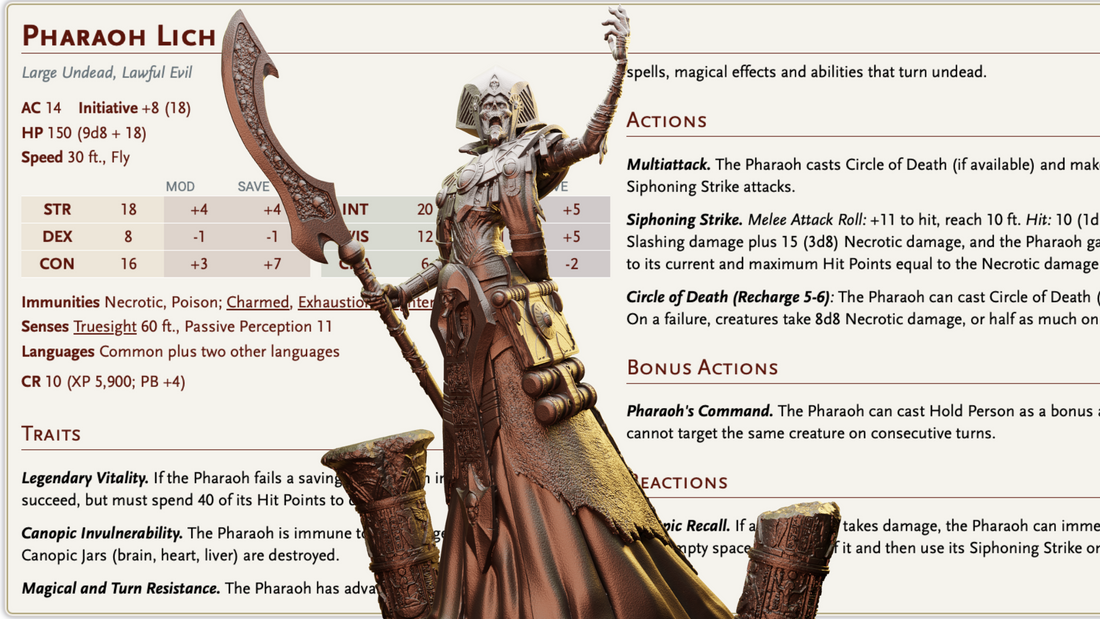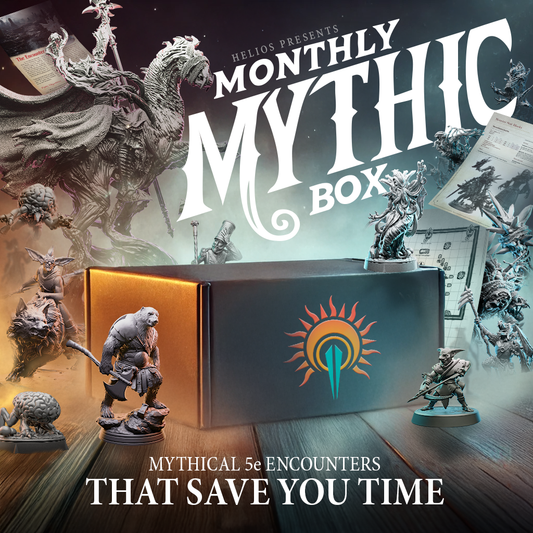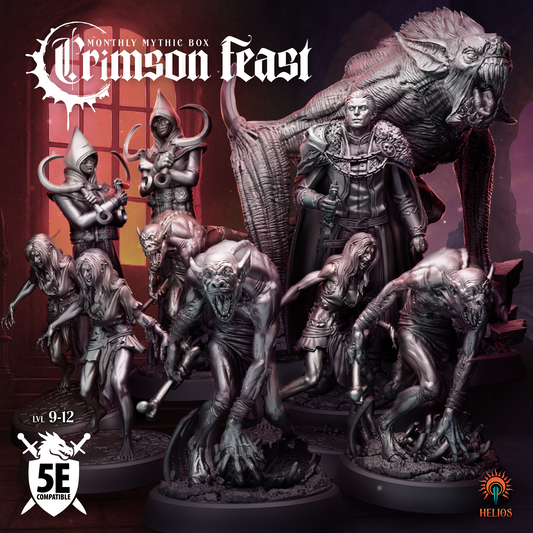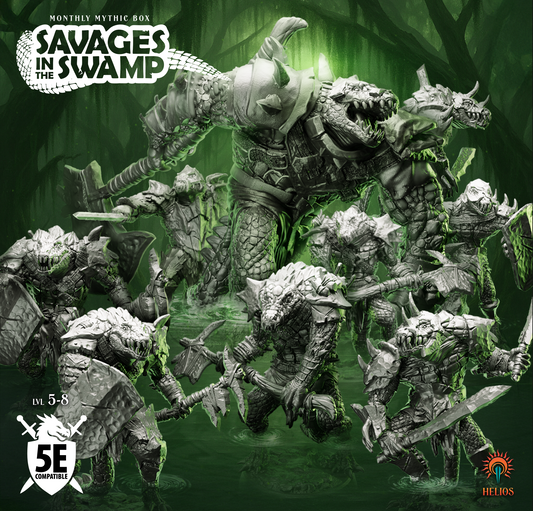
5 Mistakes to Avoid for Better Combat in D&D 5e
Share
If you've ever Googled "how to run better combat in D&D 5e" you're not alone. As Dungeon Masters, we all struggle at times with making combat encounters feel dynamic, exciting, and fresh, rather than a repetitive cycle of deleting hit points.
But the good news is, with a few key tweaks, you can transform your D&D battles from feeling like a chore to thrilling, story-driven clashes that have your players on the edge of their seats. In this post, we'll dive into the 5 most common combat mistakes DMs make, and share actionable tips to avoid them.
And if you're looking for a little extra help, be sure to check out the Helios Tabletop 5e Mythic Encounter Boxes - they're packed with high-quality 3D printed minis, custom terrain, and narrative-driven encounter designs to make your next combat truly unforgettable.
Mistake #1: Every Fight Is a Hit Point Grind
You know the feeling - your players enter a room, roll initiative, and then it's just round after round of hacking away at enemies and watching HP bars slowly tick down. These long, repetitive battles can quickly sap the tension and excitement from combat.
The fix? You need to make the combat more dynamic! Add objectives, timers, or puzzle-like enemy mechanics to your encounters. For example, maybe the players need to protect a VIP, disable a magical trap, or retrieve a stolen relic before the bad guys escape. Or perhaps the enemies have special abilities that force the players to adapt their tactics on the fly.
Incorporating these kinds of dynamic, story-driven elements can transform a standard hit point grind into a thrilling, high-stakes clash. And don't forget to apply these to boss fights too! Elements like environmental hazards, phased abilities, and narrative twists can make even solo boss encounters feel cinematic and unforgettable.
Mistake #2: Ignoring the Battlefield
Too often, combat becomes a matter of just standing around and trading blows which really sucks the excitement out of a battle that has the potential to be epic. To avoid this, look no further than the battlefield itself and use this powerful tool to add depth and excitement to your encounters.
Try incorporating dynamic D&D battle maps with terrain effects, elevation changes, destructible elements, and other environmental hazards. Our Cavern of Kobolds Mythic Box is a perfect example on getting the most out of your environment. From spike traps, crossing rivers of lava, to hoards of dragon gold and other spoils, and even solving puzzles to open magical doors, the environment of this encounter is just as treacherous as the kobolds that inhabit it!
By making the environment another factor for your players to keep in mind during combat, you can encourage more tactical, movement-based gameplay and keep your players on their toes. Not to mention, our Mythic Boxes come with original, dynamic battlemaps that will really take your next encounter's environment to the next level and make it easier than ever to bring cinematic battlefields to life.
Mistake #3: No Clear Stakes or Story Hook
When combat feels disconnected from the larger narrative, it's easy for players to treat it like a simple obstacle to overcome so they can move onto the rest of the story rather than a meaningful high-stakes battle that really gets them excited and engaged. By focusing on how your encounters fit into the main story, you can imbue a stronger sense of importance and urgency making them something your players look forward to rather than looking forward to them ending.
Adding narratives that influence the combat like making the players are race against the clock to stop a ritual before it's completed, or facing a moral dilemma where there's no clear "right" answer give your players a reason to care about the outcome beyond just surviving the fight and killing the monsters.
We take extra care when creating our Mythic Boxes to ensure the encounters go beyond just fighting monsters and give you the tools as a DM to build a compelling story that makes your combat much more thrilling for your party. Each box comes with built-in narrative hooks and lore to help you craft encounters that feel like they matter to the overall story so you don't have to do all the heavy lifting yourself.
Mistake #4: Combat Takes Forever
There's nothing worse than a combat encounter that drags on for hours, burning out your players before the session is even halfway done. Combat doesn't have to be this way though, with a few simple tweaks, you can keep the action moving and your players engaged, creating a good pace that doesn't feel rushed or make combat take an eternity.
First, consider using initiative trackers, pre-rolled dice, and other tools to streamline the turn order and reduce downtime. You can also experiment with time pressure mechanics, like having the enemies attempt to escape or complete an objective if the players don't act quickly enough.
Don't forget to encourage your players to be prepared between their turns. We’ve all dealt with that one player who zones out or goes on their phone the second their turn is over, only to freeze when it’s their turn again, slowing the pace for the entire table. This loss of momentum can be catastrophic and cause the rest of the party to disengage or lose in interest in the combat. Sometimes there's not much you can do but if you set clear expectations and gently remind them to plan ahead, you’ll keep the momentum going. A simple “you’re up next” nudge can go a long way, and over time, most players will get into the rhythm. Quick turns mean more action, tighter pacing, and way more fun for everyone at the table.
By keeping the pace brisk and your players on their toes, you can turn even lengthy battles into thrilling, edge-of-your-seat experiences.
Mistake #5: Enemies Act Like Idiots
Nothing ruins the immersion of a combat encounter quite like enemies who don't seem to have any coherent plan or tactics - acting like dumb NPCs from a *rhymes with methesda* video game. When the bad guys just stand around and take hits, it can feel like you're fighting cardboard cutouts rather than cunning, dangerous foes. Sure, a goblin grunt shouldn't have the intellect and strategy of a evil ancient sorcerer but that doesn’t mean they should fight like headless chickens either. Even low-level enemies can act with purpose: flanking allies, triggering traps, or following simple commands from a boss. Giving your monsters even a hint of tactical behavior makes combat feel more alive and keeps your players on their toes. After all, a goblin that runs screaming for reinforcements is way more memorable than one that just stands there and swings.
By imbuing your monsters with a sense of purpose and intelligence, you can create more dynamic, unpredictable battles that keep your players on their toes.
We pride ourselves on embedding witty and strategic combat mechanics in all our Helios Tabletop Mythic Boxes so you don’t have to do all the work yourself. Many of the encounters feature enemies with exciting mechanics and even tactics that shift mid-fight, forcing players to adapt their strategies on the fly.
Whether it’s a kobold shaman completing a ritual that awakens a dragon out of stone, or a pharoah lich and his undead army the regenerate hitpoints each turn, these dynamic twists keep combat fresh, cinematic, and deeply memorable. So if you’re tired of cookie-cutter combat, let us handle the heavy lifting! Your next legendary encounter is just one Mythic Box away.
With these tips and tricks in your DM toolkit, you'll be well on your way to running more dynamic, engaging combat encounters that have your players begging for more. And if you need a little extra help, be sure to check out the Helios Tabletop Mythic Boxes - they're designed to make your next D&D 5e campaign unforgettable.
Unbox your next thrilling 5e encounter with Helios Tabletop today!





